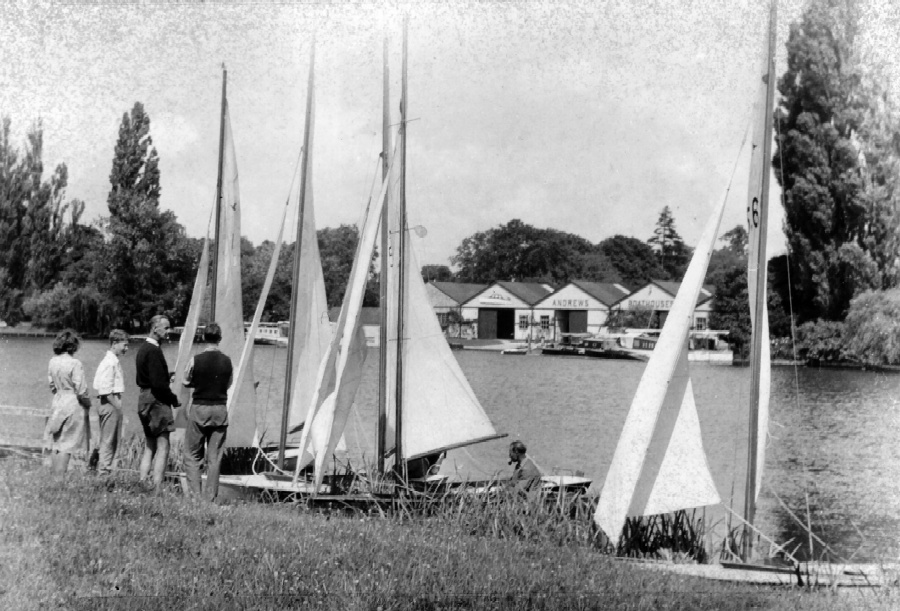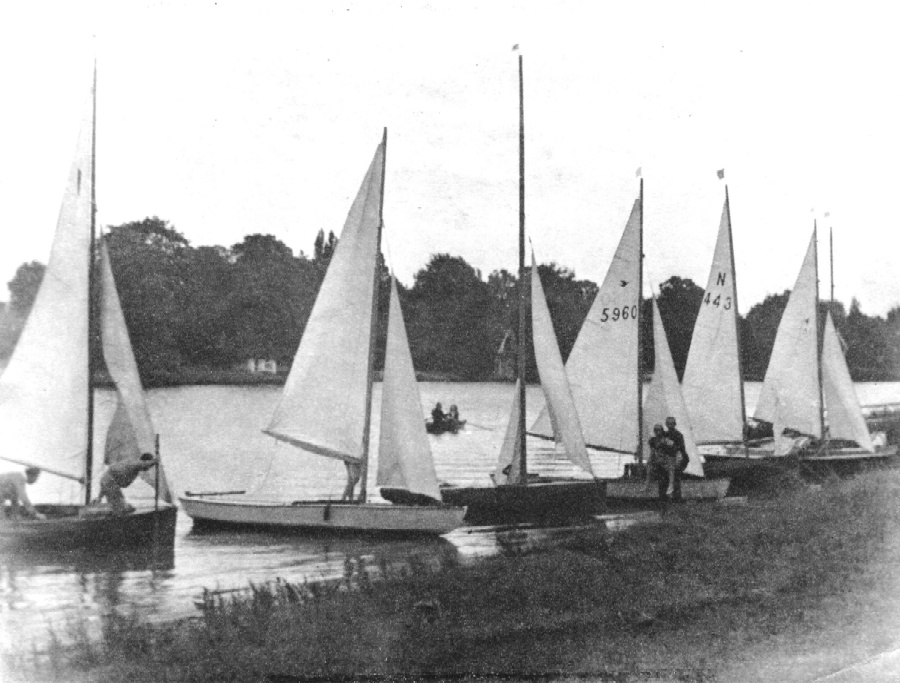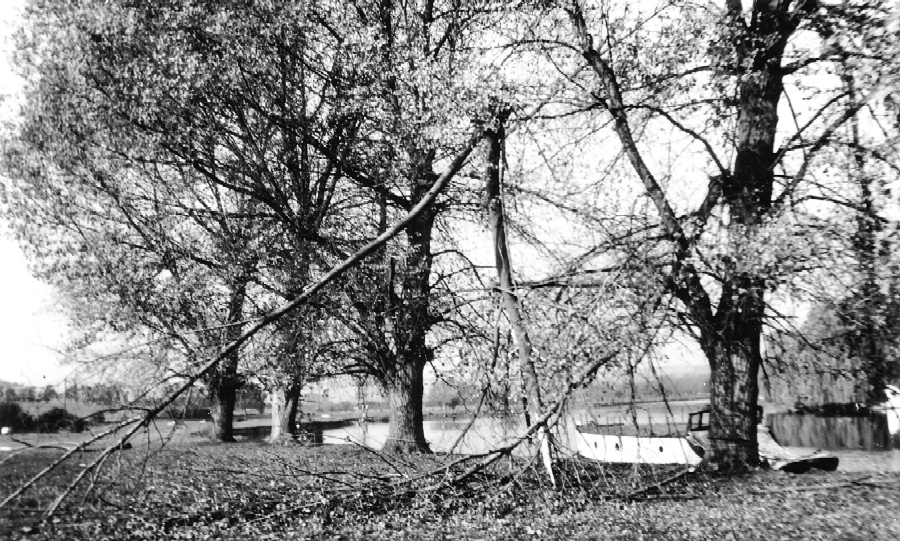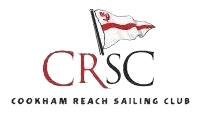The early days of CRSC compiled from the reminiscences of John Weatherall, Douglas May, Guy Pearce, Gerry Burnham, Roy Lawrence and Bob Deacon.
How it all began
It all started in 1946 at Townsend’s Boatyard (now Bourne End Marina) where a group of sailing enthusiasts stored their dinghies. The Second World War had recently ended – now was the time to begin having fun again.
The people and the boats
Wally Wallace who sailed with his wife Dee had built his Snipe, Dark Lady, in a local garage where Ray Birks had also built his Snipe called Pax. ‘Wilky’ Wilkinson and Douglas May launched their home-built Snipe, Sha Nu, on 2nd June 1946. Douglas May wrote: ‘All three Snipes were registered with the International Association and received the first sail numbers allocated in the UK after WW2’. Wally and Douglas were founders in 1945 of the Smith’s Industries Sailing Club.
Arthur Weatherall arrived later the same year with his newly-acquired dinghy Nereus which he had bought with money from a matured insurance policy. She was a Cooper One design built at Conyer Wharf in Kent. It was a shapely boat, clinker built in mahogany with a beautiful deep aerofoil rudder but a large and heavy steel centre plate.
Guy Pearce came down to the boatyard to have a look at a canoe advertised for sale in the local paper by John Weatherall, Arthur’s son. Hearing Arthur Weatherall wax lyrical about his sailing boat, Guy (a sailing novice) decided to forget the canoe and go for a proper boat with sails. He parted with his camera and equipment and for £50 bought a heavy 14ft clinker built, gaff-rigged sailing boat called Arne.
Guy described his first sail as follows: ‘The thrill of seeing your very first boat enter the water from the back of a furniture van was a sight I’ll never forget. But how do you sail the thing? This bloke Weatherall wasn’t much help. Betty and I took the plunge. All I know was that you zig zag up the wind. That Sunday was warm and we had a pleasant breeze for our maiden voyage up the Upper Thames reach. Then we heard a bang and ten minutes later 25 fast International 14s came at us. I nearly died with fright. It was straight up the bank into the reeds.’
Both Guy and Arthur later bought Snipes while Ray Birks exchanged his Snipe for a Merlin called Destiny.
Forming a club
The band of enthusiasts used to meet at the Quarry – a café with a bar on the riverbank opposite Townsends. Wally was a great organiser and conversation soon got round to starting their own sailing club. At that time Upper Thames Sailing Club would not consider another class of boat.
One weekend Wally introduced Arthur Speechly who sailed Fireflies and Nationals on the Welsh Harp and knew about club and sailing management.
Early in 1948 they had an inaugural meeting to form a new club. Wally was elected commodore and Guy secretary. When Guy found his business commitments took up too much time, Arthur Speechly took over his role – a post he held for many years. Others present at the meeting included Ray Birks, Douglas May, Arthur and John Weatherall.
John Weatherall remembers: ‘We decided to hold races on the same reach as UTSC, we did however put down our own buoys. Naturally UTSC did not approve and suggested that we should race on the next reach down, below the railway bridge. To get there we had to negotiate the bridge, but we quickly got the hang of pulling our boats onto their sides and walking them through.’
Wally designed the new club’s burgee and start/finish line and buoys were provided by Ray Birks. The starting flagstaff was fastened to a convenient piece of fence opposite Andrews’ Boathouse. There was an adjacent sandy bay which made landing easy and where members could picnic in their boats.

The club still met at the Quarry. John Weatherall recalls: ‘One gusty day we watched a shiny National 12 pull out into the river from Townsends. A couple of squalls later it filled and capsized. It was righted and continued towards us where willing hands hauled the crew ashore and tied up their boat. A dripping Ernie Stocks introduced himself and so joined the new club.’

The Club attracted interest in Cookham and in 1948 a Mr Lilley said he had a garden which was far too large for him. He guessed that the Club wanted a base on the reach and generously offered a piece of it at a peppercorn rent. This land was about one third of the present site. It was Ernie Stocks who negotiated the deal with Mr Lilley. ‘On the first day,’ Guy Pearce remembered, ‘we erected a small tent, procured a five gallon drum to stand a primus on for tea. Cookham Reach Sailing Club had definitely arrived’.

Getting things organised
The winter that year was spent fencing off the Club’s newly acquired spot. Access to the site was from Berries Road. The publican at the Crown Inn was friendly and offered an old hall adjacent to the pub as a meeting room. There was also room for changing and toilets. It was a comfortable clubhouse but it meant everyone had to change there before walking down to the boats and back afterwards. And of course all the flags for starting races and any other equipment also had to be carried to and fro. Boats were launched by the Ferry Inn and paddled upstream to the Club.
Sailing in the early days
In 1949 there were three Merlins – Belladonna (Guy Pearce), Flittermouse (Sid Bellam) and Wizard Arthur (Arthur Weatherall). John Weatherall had built himself a YW Cadet he named Sprite. It was No 77 and there’s a photo of it in the 1948 Yachting World Annual. Two other Cadets put in an appearance – one built by David Osario while he was still at school.
At around the same time the Club heard that the fleet of Herons sailing on Ruislip Lido could not stay there in the summer so they were invited to join the Club. In this way the club acquired at least three additions to its working parties as well as tea ladies.
Gerry Burnham continues the story: ‘I was a school friend of Roger Hawkes. He knew Wally and was approached by him to join the Club as they were short of crewing members. Roger said if I were to join, he would too. That was in August 1951. ‘The first week I went down there were trees along the whole of the Berkshire bank. The following week the trees from the corner up to the top of the reach had been felled.’ By this time John Weatherall had acquired his dream boat, a blue National 12 which he had admired at Woottons boatyard for some time. One of the first crews in this new boat was Roger Hawkes.
In 1952 Ted Clark presented a cup for novices to the Club – it was the best three races to count out of six. As it was won by the same person in the first two years, it was decided that you could not enter for the cup once you had won it, or indeed any other trophy. This was the start of the current Harbour Cup. Sadly the original cup made of solid silver was stolen from the house of the then holder sometime in the 60s or 70s.
Ted Clark was a familiar figure at Cookham Reach where for some years he and his wife Rene kept their small sailing cruiser Festina.
The Clubhouse goes up
Roy Lawrence, who was the first member to be elected by the Club, had a very infectious laugh which became well known to the other members. When it came to designing and building a Clubhouse he was invaluable. Here’s what he wrote about it: ‘The original Clubhouse was very much a DIY effort. Our company junior architect was persuaded to design the building as part of his submissions for his AMIRBA. A quantity surveyor member prepared the estimates which were far too high, so we had to set about scrounging materials. I together with Ernie Stocks laid the bricks. Jim Taylor constructed the timber frames at his caravan works at Farnham and, after a hair-raising journey with them standing upright on a caravan chassis, they arrived at Cookham. Two bank clerks were told to lay the nailed flooring. “Never done it before? Now’s your chance to learn!” And a splendid job they made of it.’
Bob Deacon remembers the Clubhouse when he first became a member. ‘It was much smaller in those days. You can still see the join in the floor across the middle of the club room. There was no kitchen as such, just a serving counter where the dart board is now. The changing rooms were annexed on. The ladies’ changing room was pulled down to make room for the present entrance steps and the ‘gents’ is now the entrance lobby. Toilet facilities were outside – Elsans (chemical buckets) housed in little huts at the back. This was a job I was soon to inherit – emptying buckets into a cess pit became the major responsibility of the Harbour Master, a role I performed for many years.’
Gerry Burnham adds: ‘The Clubhouse was opened in 1954 by a local dignitary, Mr Brightman. He had some sway with the local council. He persuaded the authorities that the remaining trees up to the corner were dangerous and should be cut down. Mr Brightman was made an honorary member of the Club.’
Sorting out the land and trees
Around the time the Clubhouse was going up the Club managed to get the use of a triangle of land at the end of Berries Road. This meant that members could pull their boats down to the towpath and then to the Club site. Mr Phillips lived in the house on the Bucks bank which was on the corner of the Club’s reach. The house is the one with the boat house and the weeping willow. He also owned the land on the opposite side of the river up to the existing hedge. A sewage farm was built on the other side of the hedge and Mr Phillips planted trees on all of the land, with the exception of the tow path, to help stop the smell.
The Club was concerned that these trees would spoil the sailing on the reach so decided to negotiate buying the land from Mr Phillips so that they could cut down all the trees. They contacted all the residents on the Bucks bank to let them know what the Club would be doing. They slapped a tree preservation order on the trees. The Club appealed against this and it was agreed that they could cut them down provided that they planted about a dozen different types of trees in the hedge by the sewage farm, which they duly did.
Meanwhile the Club were trying to purchase from Mr Copas the piece of land which is now the car park. Mr Copas wanted the land which had been bought from Mr Phillips. So a swap was arranged – and Mr Copas cut down the trees.

Up and running
No trees to hamper the wind, a beautiful stretch of the river, a safe and accessible haven for boats, an efficient starter’s box and a clubhouse to be proud of, not to mention an ever-growing band of enthusiastic members – Cookham Reach Sailing Club was really in business, and remains so to this day!
Further Reading
- Minutes of the Inaugural CRSC Meeting
- Trophy Winners (access to members only)
